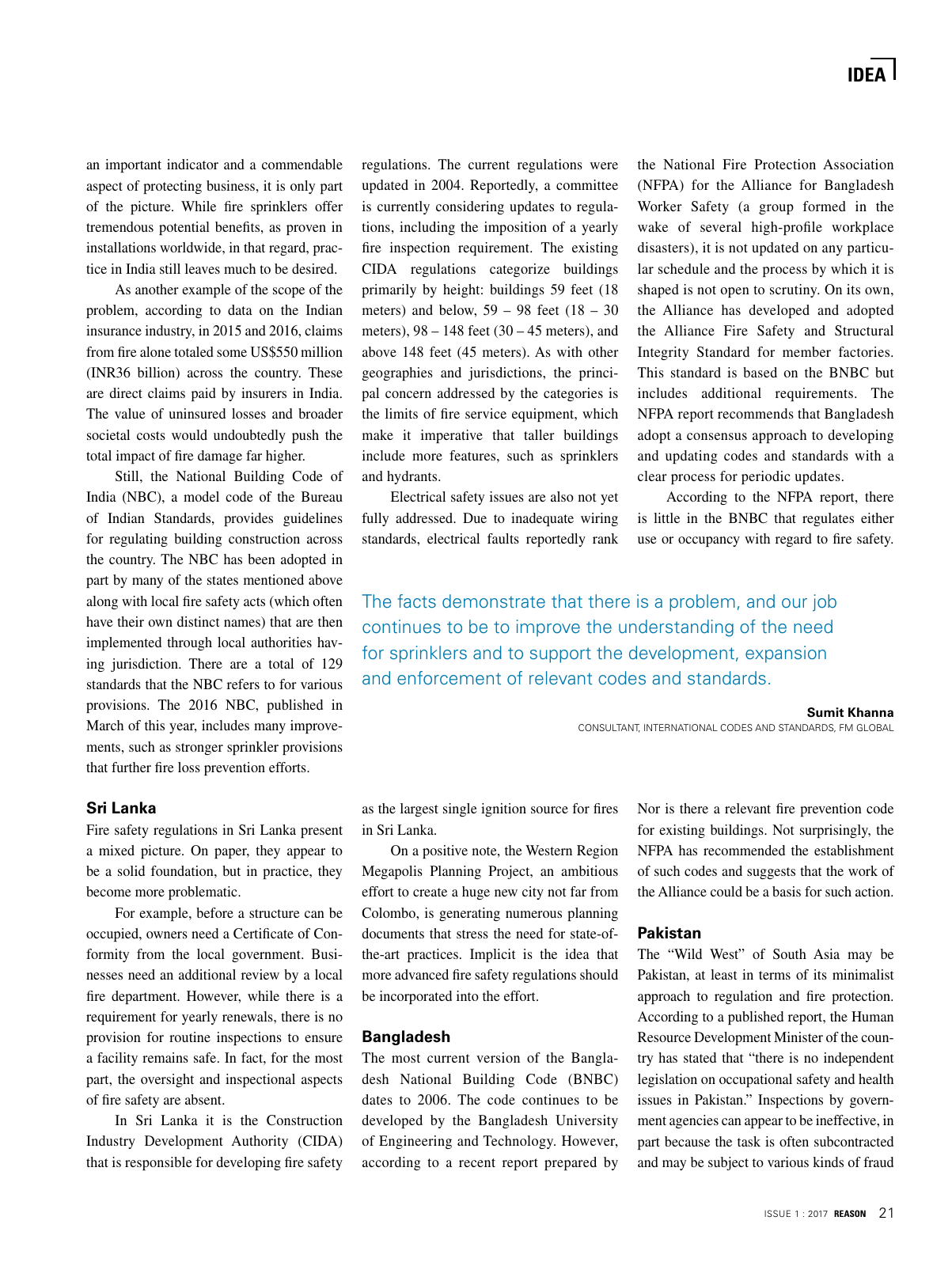IDEA an important indicator and a commendable aspect of protecting business it is only part of the picture While fire sprinklers offer tremendous potential benefits as proven in installations worldwide in that regard prac tice in India still leaves much to be desired As another example of the scope of the problem according to data on the Indian insurance industry in 2015 and 2016 claims from fire alone totaled some US 550 million INR36 billion across the country These are direct claims paid by insurers in India The value of uninsured losses and broader societal costs would undoubtedly push the total impact of fire damage far higher Still the National Building Code of India NBC a model code of the Bureau of Indian Standards provides guidelines for regulating building construction across the country The NBC has been adopted in part by many of the states mentioned above along with local fire safety acts which often have their own distinct names that are then implemented through local authorities hav ing jurisdiction There are a total of 129 standards that the NBC refers to for various provisions The 2016 NBC published in March of this year includes many improve ments such as stronger sprinkler provisions that further fire loss prevention efforts Sri Lanka Fire safety regulations in Sri Lanka present a mixed picture On paper they appear to be a solid foundation but in practice they become more problematic For example before a structure can be occupied owners need a Certificate of Con formity from the local government Busi nesses need an additional review by a local fire department However while there is a requirement for yearly renewals there is no provision for routine inspections to ensure a facility remains safe In fact for the most part the oversight and inspectional aspects of fire safety are absent In Sri Lanka it is the Construction Industry Development Authority CIDA that is responsible for developing fire safety regulations The current regulations were updated in 2004 Reportedly a committee is currently considering updates to regula tions including the imposition of a yearly fire inspection requirement The existing CIDA regulations categorize buildings primarily by height buildings 59 feet 18 meters and below 59 98 feet 18 30 meters 98 148 feet 30 45 meters and above 148 feet 45 meters As with other geographies and jurisdictions the princi pal concern addressed by the categories is the limits of fire service equipment which make it imperative that taller buildings include more features such as sprinklers and hydrants Electrical safety issues are also not yet fully addressed Due to inadequate wiring standards electrical faults reportedly rank as the largest single ignition source for fires in Sri Lanka On a positive note the Western Region Megapolis Planning Project an ambitious effort to create a huge new city not far from Colombo is generating numerous planning documents that stress the need for state of the art practices Implicit is the idea that more advanced fire safety regulations should be incorporated into the effort Bangladesh The most current version of the Bangla desh National Building Code BNBC dates to 2006 The code continues to be developed by the Bangladesh University of Engineering and Technology However according to a recent report prepared by the National Fire Protection Association NFPA for the Alliance for Bangladesh Worker Safety a group formed in the wake of several high profile workplace disasters it is not updated on any particu lar schedule and the process by which it is shaped is not open to scrutiny On its own the Alliance has developed and adopted the Alliance Fire Safety and Structural Integrity Standard for member factories This standard is based on the BNBC but includes additional requirements The NFPA report recommends that Bangladesh adopt a consensus approach to developing and updating codes and standards with a clear process for periodic updates According to the NFPA report there is little in the BNBC that regulates either use or occupancy with regard to fire safety Nor is there a relevant fire prevention code for existing buildings Not surprisingly the NFPA has recommended the establishment of such codes and suggests that the work of the Alliance could be a basis for such action Pakistan The Wild West of South Asia may be Pakistan at least in terms of its minimalist approach to regulation and fire protection According to a published report the Human Resource Development Minister of the coun try has stated that there is no independent legislation on occupational safety and health issues in Pakistan Inspections by govern ment agencies can appear to be ineffective in part because the task is often subcontracted and may be subject to various kinds of fraud The facts demonstrate that there is a problem and our job continues to be to improve the understanding of the need for sprinklers and to support the development expansion and enforcement of relevant codes and standards Sumit Khanna CONSULTANT INTERNATIONAL CODES AND STANDARDS FM GLOBAL ISSUE 1 2017 REASON 21

Hinweis: Dies ist eine maschinenlesbare No-Flash Ansicht.
Klicken Sie hier um zur Online-Version zu gelangen.
Klicken Sie hier um zur Online-Version zu gelangen.